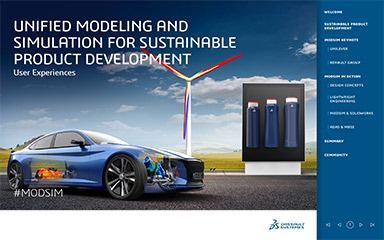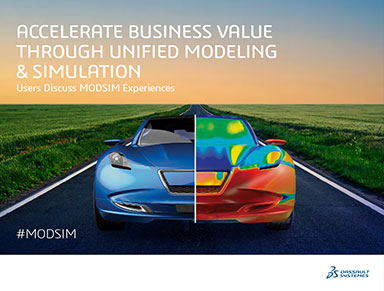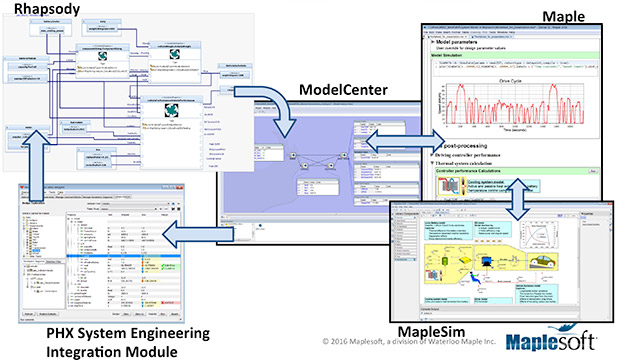Model-Based Systems Engineering Tackles Product Complexity
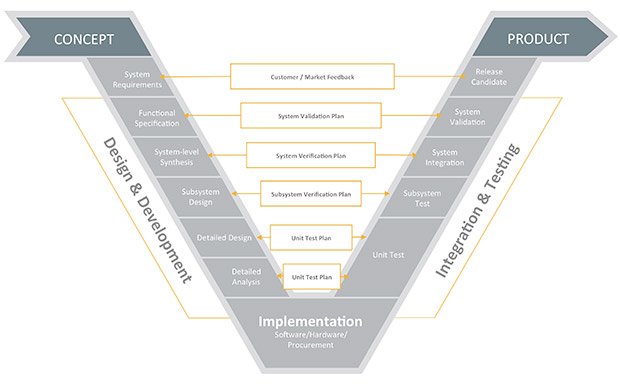
The system design process is often represented as a V diagram to indicate the importance of verifying the design against its requirements throughout every stage of the process.
Latest News
June 16, 2017
By Bruce Jenkins of Ora Research
Automotive and off-highway were the first industries forced by the mechatronics revolution to move their engineering practices out of habits rooted in 1950s-era product architectures, into 21st century methods grounded in simulation-led, systems-driven product development. Today’s smart, connected, self-aware and situationally aware cars, trucks and agricultural and construction equipment—managed by ultra-sophisticated onboard mechatronic systems-of-systems—are almost as far advanced from earlier-generation mechanical devices governed by primitive electromechanical (if that) control systems as relativity and quantum mechanics were from the classical physics of Newton and Maxwell. Products of that complexity simply can’t be successfully developed, integrated and validated using last-century tools and methods that leave discovery and remediation of system-level design flaws until detail design or even, disastrously, delivery to market.
Systems Engineering Capability Gaps
One industry plagued by high profile, widely publicized systems engineering failures is lithium-ion (Li-ion) batteries. As use of these compact, efficient power sources spreads to more products and industries, the technology has garnered notoriety from repeated cases of thermal runaway—overheating, fires, even explosions of mobile phones and laptop computers, and fires in lithium-ion battery arrays powering new-generation commercial aircraft. Those embarrassments led to costly recalls and a ban on Li-ion batteries as freight on passenger aircraft.
All this dramatizes the urgent need for new, more accurate and effective methods to design the thermal management systems (TMS) critical to control temperature, optimize performance and maximize operating life of Li-ion batteries. A correctly engineered TMS is essential to meet those goals, as high performance and long operational life can be achieved together only by keeping battery temperature within a narrow range near room temperature—the optimal thermal operating condition for Li-ion technology—even as operating conditions and current demands on the pack vary widely across each use cycle. Helping engineers model, explore and optimize tradeoffs between competing design goals such as high performance versus long life is a key ability provided by systems modeling and model-based systems engineering (MBSE).
Unprepared Industries Diving into MBSE
Indeed, driven by the twin revolutions of the Industrial Internet of Things and Industry 4.0, the urgent requirement to gain capability and proficiency in MBSE is about to come crashing down on many different industries—general industrial machinery, medical devices, consumer durables and more—that today are, in great part, woefully unprepared.
 The system design process is often represented as a V diagram to indicate the importance of verifying the design against its requirements throughout every stage of the process.
The system design process is often represented as a V diagram to indicate the importance of verifying the design against its requirements throughout every stage of the process.An essential technological enabler that will let these industries ready themselves to manage and master this looming revolution is system-level physical modeling and simulation. This technology empowers engineers and engineering teams to begin studying, exploring and optimizing designs in the beginning stages of projects, when informed engineering decision-making can have its strongest impact and leverage on product development outcomes. Then, properly applied, systems modeling and simulation can help engineering teams maintain visibility and control at the subsystems, systems and whole-product levels as the design evolves through development, optimization, integration and validation, as illustrated already.
The ROI is compelling. Beyond avoiding the direct costs, brand damage and liability exposure of product failures and recalls, MBSE can dramatically reduce product development budgets and schedules. Early visibility into system-level design issues lets engineering flaws be found and fixed up front, reducing and even eliminating the need for budget contingencies for late-stage changes during physical prototyping and test—savings that can often total hundreds of thousands of dollars in a project, sometimes even more. MBSE also makes it much easier for engineers to explore what-if scenarios and readily see how their changes impact the product and its behavior.
Research for this article was commissioned from Ora Research by Maplesoft.
Requirements Guarantee Design Performance by Automating Compliance Validation
Before system-level physical modeling and simulation software can be brought to bear in product development, product requirements have to be captured and documented. Traditional requirements are that management processes are based on static documents typically created and maintained with basic digital tools such as Word or Excel. They’re time-consuming, labor-intensive and error-prone. What-if scenarios are difficult to explore because of the long time required to make even small design changes, and because the massive documentation requirements are overwhelming, on top of becoming quickly—and repeatedly—outdated.
But today, these problems are being dramatically remedied by sophisticated software applications based on the SysML systems modeling language—IBM Rational Rhapsody, No Magic MagicDraw, ViTech CORE and others. These automated solutions effectively and efficiently capture and manage the system architecture expressed in terms of its subsystem structure, and how the subsystems are expected to behave according to the detailed requirements.
MBSE Software Tools: Architectural vs. Analytical
However, those requirements are purely descriptive. SysML-based solutions are architectural tools used by engineers to define what the system is required to do. To help engineers discover how to achieve that what, an entirely different category of analytical tools is necessary—this is where system-level physical modeling and functional simulation software comes into play.
Typically, the first step in determining the “how” is to develop a system-level functional mockup that incorporates the dynamic behaviors of all the product’s subsystems, and models how they interact. This can be done using any of the various commercially available analytical software applications for system-level physical modeling. This functional mockup provides early visibility into the design’s essential performance attributes at a level of fidelity sufficient to give engineers insight into how the system will behave, in order to discover and remedy any design shortcomings and failure modes early in the development cycle.
One example of a multi-domain system-level modeling tool suited for this is MapleSim, which is based on Modelica, an open, object-oriented, system-level modeling language. MapleSim lets engineers and designers incorporate components from differing domains into their systems models, and take advantage of the ever-expanding Modelica libraries of specialized product components. Modelica models and components are open, modifiable, and easy to reuse, extend and customize.
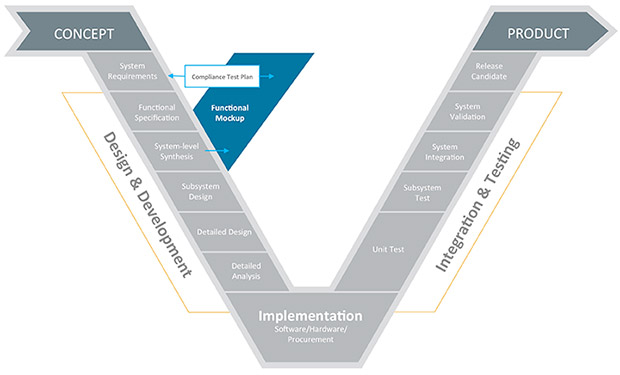 Consistent mapping between requirements and the physics that determine a system’s behavior makes it easy to perform compliance tests to verify a design against its requirements throughout every stage of product development.
Consistent mapping between requirements and the physics that determine a system’s behavior makes it easy to perform compliance tests to verify a design against its requirements throughout every stage of product development.Models created in MapleSim can be structured to reflect exactly the system definition in order to provide a consistent mapping between requirements and the physics that determine the system’s behavior. This structure makes it easy to perform the needed compliance tests for individual subsystems as well as the complete system-level product model.
Digitally Link Architectural & Analytical Environments
Typically, with multiple engineers and disciplines involved in product development, there is much interaction among the various stages of the design process. New information acquired at each stage must be incorporated into the design. One technology that can enable and automate interaction, data interchange and workflows among the multiple software tools required for this process is Phoenix Integration’s ModelCenter software suite—a flexible, open, easy-to-use simulation management tool designed to capture, organize and share processes, models, input data, results and conclusions generated during MBSE.
A new approach uses the combination of MapleSim and ModelCenter to let designers create a complete, robust modeling and simulation environment that automates the process of systems architecture functional verification. In this scheme, the ModelCenter tool suite brings together the systems engineering modeling tools and the analytical tools in an interactive and managed framework. Applied to manage this complex process, ModelCenter can help systems engineers carry out the compliance tests necessary throughout design and development more easily, efficiently and free from risk of manual error.
At the same time as ModelCenter ties together various analytical tools such as Maplesoft’s MapleSim and its Maple mathematical computation tool in an integrated, automated managed workflow, its Systems Engineering Integration Module connects the SysML-based modeling tools to the ModelCenter workflow. In this workflow, Maple extracts parameter values from ModelCenter, enters those values into MapleSim and manages execution of the data analysis. ModelCenter coordinates data transfer among, and processing by, the various tools employed in any given engineering design activity. This connected and automated workflow reduces both project schedule and risk of manual error.
By providing intelligent, automated connection of model compliance testing to model performance analysis, this approach lets engineers rapidly and fluently test and evaluate varying controls until they arrive at an analytical product model that satisfies all the design requirements documented in the SysML model.
MapleSim is a software tool ideally suited to creating high-fidelity analytical functional models that support and satisfy all the objectives and goals of model-based systems engineering. And the powerful synergies that result from the combination of MapleSim and ModelCenter create a cohesive digital environment that reduces cost, schedule and risk by seamlessly and automatically connecting and coordinating every phase of engineering design exploration, development, integration and validation.
Bruce Jenkins is president of Ora Research, a research and advisory services firm focused on technology business strategy for 21st-century engineering practice.
Subscribe to our FREE magazine, FREE email newsletters or both!
Latest News
About the Author
Bruce Jenkins is president of Ora Research (oraresearch.com), a research and advisory services firm focused on technology business strategy for 21st-century engineering practice.
Follow DE




